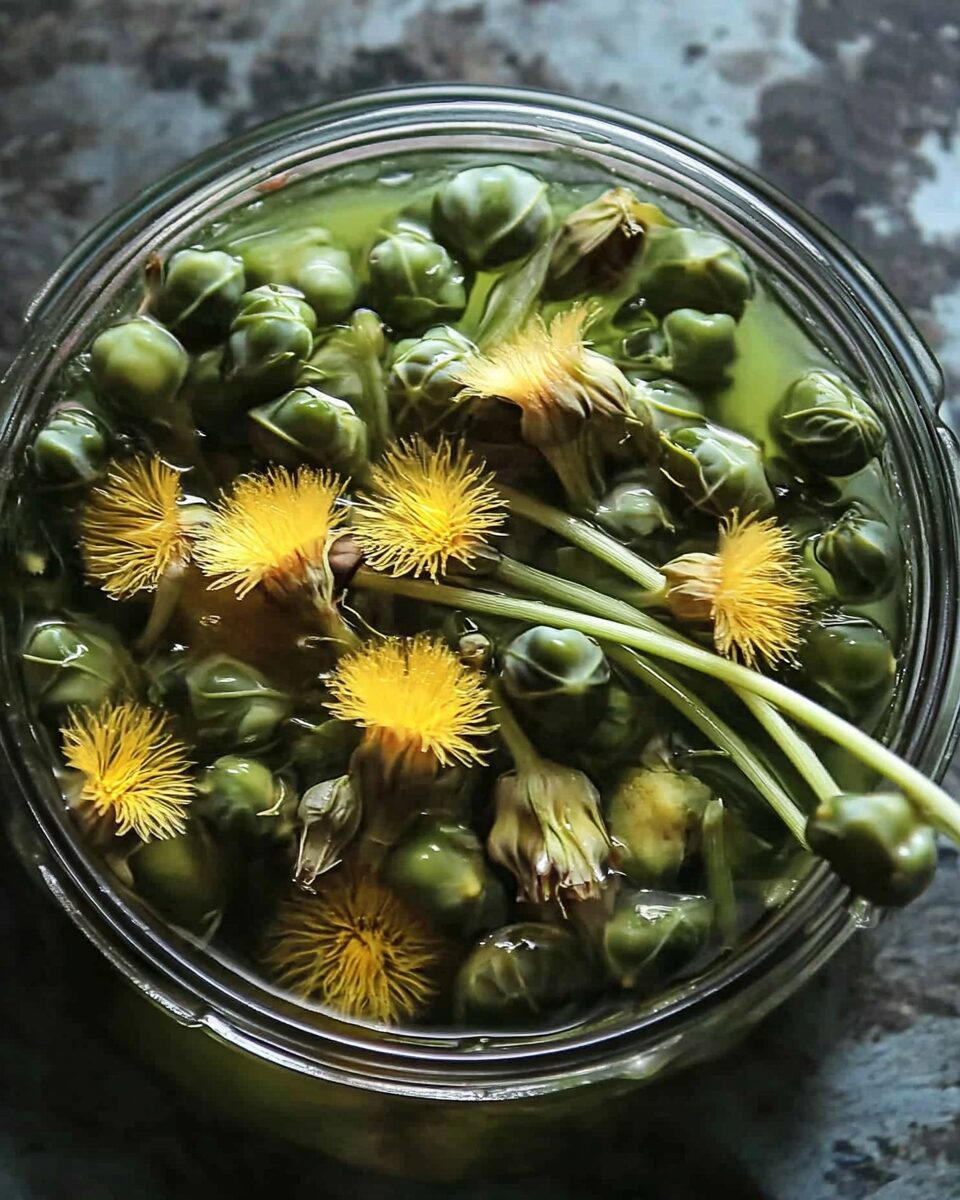Dandelion Capers are a creative and tangy substitute for traditional capers, made using the unopened flower buds of the common dandelion. These little bursts of flavor are preserved in a vinegar brine, making them perfect for enhancing pasta, salads, or charcuterie boards. It’s a great way to use a wild ingredient often overlooked in nature’s pantry.
FULL RECIPE
Ingredients
- 1 cup dandelion flower buds (unopened)
- 1 tablespoon salt
- ½ cup white wine vinegar (or apple cider vinegar)
- ½ cup water
- 1 garlic clove (optional, for flavor)
- ½ teaspoon mustard seeds (optional)
- ½ teaspoon black peppercorns (optional)
Directions
- Harvest 1 cup of tightly closed dandelion buds, avoiding any that have started to open.
- Rinse the buds thoroughly to remove dirt and insects.
- Place the buds in a small bowl and sprinkle with 1 tablespoon of salt. Mix and let sit at room temperature for 24 hours to draw out bitterness.
- After 24 hours, rinse the buds well and drain.
- In a small saucepan, combine the vinegar, water, garlic (if using), mustard seeds, and peppercorns. Bring to a boil.
- Add the rinsed buds to the brine and simmer gently for 2-3 minutes.
- Remove from heat and transfer everything to a sterilized glass jar.
- Seal the jar and let it cool, then refrigerate. Allow to marinate for at least 1-2 weeks before using for best flavor.
Nutritional Information
- Calories: 5
- Carbohydrates: 1g
- Fat: 0g
- Protein: 0g
- Sodium: 150mg (varies based on salt rinse)
- Fiber: 0.2g
The History and Origins of Dandelion Capers
While we often think of dandelions as weeds, they have a long history of use in both food and medicine. Across Europe, dandelions have been used in cooking for centuries, and their various parts—roots, leaves, and flowers—have been valued for their health benefits. The practice of pickling dandelion buds to create capers is an old tradition in certain cultures, especially where dandelions grow freely in the wild. Today, making dandelion capers is seeing a resurgence, driven by the growing interest in foraged foods and sustainable cooking.
Why Choose Dandelion Capers?
Dandelion capers offer a fresh alternative to traditional capers, which are typically made from the flower buds of the caper bush. The flavor of dandelion capers is both tangy and bitter, making them an exciting ingredient to experiment with in the kitchen. They work especially well in dishes where capers are typically used, such as pasta, salads, or even as a garnish for grilled meats. Adding dandelion capers to your dishes not only introduces a new flavor but also gives you the satisfaction of using a wild, free-growing ingredient that is both eco-friendly and sustainable.
The Nutritional Value of Dandelion Capers
Dandelions are incredibly nutritious plants. The flowers, leaves, and roots all have high concentrations of vitamins A, C, and K, as well as minerals like potassium, calcium, and iron. Though you might use only small amounts of dandelion capers in your dishes, they still pack a nutritional punch. The pickling process preserves some of the plant’s health benefits, including its antioxidant properties. This makes dandelion capers not only a flavorful addition to your meals but a nutritious one as well.
Sustainability and Foraging for Dandelions
One of the main benefits of dandelions is that they are incredibly easy to find and foraged, often growing wild in yards, fields, and gardens. They are a low-impact, sustainable food source, as they require no special cultivation or care. By foraging dandelions, you’re using a plant that grows abundantly without the need for pesticides or fertilizers, making it an ideal ingredient for eco-conscious cooks. Furthermore, foraging for dandelions can help keep their growth in check in areas where they are considered invasive, benefiting local ecosystems.
The Best Time to Harvest Dandelions
Timing is essential when harvesting dandelion buds for capers. The buds need to be picked while still tightly closed, before they bloom into flowers. The best time to harvest dandelions is in the spring, when the plants are just beginning to flower. At this stage, the buds are still tender and have the ideal flavor for pickling. Harvesting them before they open ensures you get the mildest, most flavorful buds. Always make sure to choose dandelions that have not been treated with pesticides or chemicals, especially if you’re foraging from a public area.
Preserving Dandelion Capers
To preserve dandelion buds and turn them into capers, they need to be pickled in a brine solution. This brine is typically made of vinegar, water, salt, and sometimes additional flavoring ingredients such as garlic or mustard seeds. The pickling process not only preserves the buds but also enhances their flavor, making them tangy and slightly salty. Once pickled, dandelion capers can be stored in an airtight jar and kept in the refrigerator for several months. As they sit in the brine, their flavors continue to develop, making them even more flavorful over time.
Using Dandelion Capers in Cooking
Dandelion capers are incredibly versatile and can be used in a variety of dishes. They can be added to salads for a burst of flavor, tossed into pasta dishes for extra tang, or used as a topping for meats such as chicken or lamb. They also work well in sauces, providing a savory, slightly bitter note that complements rich and creamy ingredients. Dandelion capers are especially popular in Mediterranean-inspired dishes, where capers are often featured. Their bold flavor allows them to pair well with both simple and complex dishes alike.
The Benefits of Making Your Own Dandelion Capers
Making your own dandelion capers offers several advantages over purchasing them. First, you have control over the ingredients and the pickling process. You can adjust the flavor by experimenting with different spices and herbs, making your capers unique to your taste. Additionally, homemade dandelion capers are often more cost-effective than store-bought options, especially since dandelions are free to harvest in your own backyard or local area. The process of making them is simple and requires only a few basic ingredients, making it a fun and rewarding DIY project.
The Role of Dandelion Capers in Reducing Food Waste
Using dandelions in your cooking is a great way to reduce food waste. Rather than allowing these plants to grow unchecked or be removed as weeds, foraging for dandelion buds allows you to make use of an abundant natural resource. By turning dandelions into capers, you’re giving new life to a plant that might otherwise be discarded. This practice is part of a larger movement toward reducing food waste and embracing sustainable, foraged ingredients in the kitchen.
Dandelion Capers as an Alternative to Traditional Capers
While dandelion capers don’t exactly replicate the flavor of traditional capers, they offer a similar tanginess and briny taste. Traditional capers come from the caper bush (Capparis spinosa), which is typically grown in Mediterranean climates. In contrast, dandelion capers are a more accessible and environmentally friendly option, as dandelions grow in a variety of climates and can be harvested without special care. Using dandelion capers in place of traditional capers allows you to experiment with new flavors while still enjoying a familiar culinary experience.
Health Benefits of Dandelions
Dandelions are considered a superfood because they are packed with essential nutrients. They contain high levels of vitamins, minerals, and antioxidants, which can help support overall health. Dandelions are especially known for their detoxifying properties, particularly in supporting liver function. Additionally, the flowers and leaves of the plant are known for their anti-inflammatory effects, making dandelions a great addition to any health-conscious diet. By incorporating dandelion capers into your meals, you can enjoy these health benefits in a convenient and tasty form.
Culinary Pairings with Dandelion Capers
Dandelion capers have a bold flavor that pairs well with a variety of dishes. Their tanginess and slight bitterness complement rich and creamy ingredients, making them ideal for pasta dishes with olive oil, butter, or cream-based sauces. They also work well in fresh salads, where they provide a sharp contrast to mild greens like arugula or spinach. Dandelion capers can be used to enhance the flavor of grilled meats such as chicken, fish, or lamb, adding a burst of acidity that balances the richness of the protein.
How to Store Dandelion Capers
Once prepared, dandelion capers should be stored in an airtight container or jar in the refrigerator. The pickling brine will help preserve the capers, allowing them to last for several months. It’s important to ensure that the capers remain fully submerged in the brine to prevent spoilage. Over time, the flavors of the dandelion capers will continue to develop, making them even more flavorful the longer they sit in the jar. Be sure to check the jar regularly for any signs of mold or spoilage, although this is unlikely if stored properly.
The Environmental Impact of Foraging
Foraging for wild plants like dandelions is an environmentally sustainable practice. Dandelions require no cultivation and are naturally abundant, making them an easy and low-impact food source. By foraging for dandelions instead of buying imported or heavily farmed produce, you help reduce your environmental footprint. Additionally, foraging helps manage dandelion populations, especially in areas where they are considered invasive, ensuring a balanced ecosystem.
Advertisement
The Taste Profile of Dandelion Capers
Dandelion capers have a unique taste that combines bitterness and tanginess. Their flavor is more pronounced than traditional capers, with a slightly earthier and more bitter note. While this bitterness can be off-putting to some, it adds a layer of complexity to dishes. The pickling process helps to mellow out some of the sharpness, allowing the tangy flavor to shine through. If you’re looking for a caper alternative that adds more character and depth, dandelion capers are an excellent choice.
How to Experiment with Dandelion Capers
The versatility of dandelion capers allows you to experiment with a variety of dishes. Try using them in a Mediterranean tapenade, as a topping for crostini, or mixed into a pesto sauce. Their distinct flavor can be used to elevate many dishes, from simple salads to more complex meat-based recipes. By exploring different ways to incorporate dandelion capers, you can discover new culinary possibilities and create unique flavors in your meals.
Conclusion
Dandelion capers are a delicious and sustainable alternative to traditional capers, offering a unique tangy, bitter flavor that can transform a variety of dishes. By making your own at home, you can enjoy the benefits of foraging, reduce food waste, and explore a creative culinary ingredient. Whether you use them in pasta, salads, or as a garnish for meats, dandelion capers offer a flavorful and eco-friendly addition to your cooking. Their nutritional benefits and versatility in the kitchen make them an exciting ingredient to try and incorporate into your meals, allowing you to embrace the wild flavors of nature.






